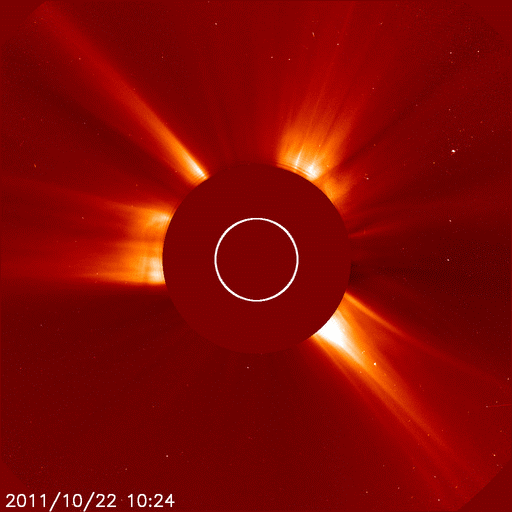
|
||||||||||||
|
|
|
Geomagnetic Storming and the Aurora
2011-10-25 12:51The Space Weather Prediction Center (SWPC) The Coronal Mass Ejection observed Saturday morning arrived late Monday (EDT and GMT), about 8 hours earlier than model guidance suggested. A single period reaching the G2 (Moderate) level was observed followed by several periods of G1 (Minor) storming. While not a terribly significant geomagnetic storm, it did happen at a time when most of the United States was dark or getting dark. Couple that with the fact that large parts of the US had very clear skies, and you've got some beautiful sightings of the aurora across the northern tier of the US. Unfortunately for sky watchers, the geomagnetic storm appears to be in decline and no further significant space weather is expected at this time.
Northern Lights as seen east of Martin, Michigan on October 24 2011 A coronal mass ejection (CME) hit Earth on Oct. 24th at approximately 1800 UT (2:00 pm EDT). The impact strongly compressed Earth's magnetic field, directly exposing geosynchronous satellites to solar wind plasma, and sparked an intense geomagnetic storm. As night fell over North America, auroras spilled across the Canadian border into the contiguous United States. Auroras were seen or photographed in more than half of all US states including Alabama, Wisconsin, New Mexico, Tennessee, Missouri, Illinois, Nebraska, Kentucky, North Carolina, Indiana, Oklahoma, Kansas, Iowa, Maryland, New York, Montana, Ohio, Colorado, Pennsylvania, Washington, Virginia, Texas, Arizona, Minnesota, Maine, Michigan, Oregon, Arkansas and California. Many observers, especially in the deep south, commented on the pure red color of the lights they saw. These rare all-red auroras sometimes appear during intense geomagnetic storms. They occur some 300 to 500 km above Earth's surface and are not yet fully understood.
Northern Lights over Mineral Point Wisconsin October 24, 2011
Credit: NOAA, Space weather, Dr. Tony Philips |





